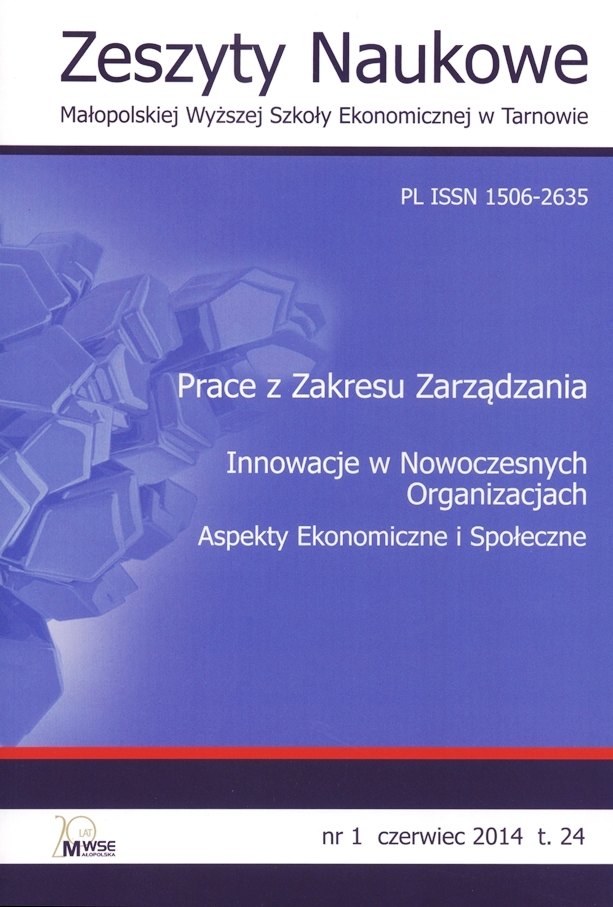Abstract
The processes which are taking place in the modern economy show that in addition to a strong position played in it by large multinational corporations, it is also important not to seek publicity in the media and overshadowed by a group of companies—determined in accordance with the concept of H. Simon, as “hidden champions”. Taking as a starting point, the H. Simons definition of the hidden champions of modern economy, we formulated the definition of a Hidden Champions of the Polish economy: dealing with first, second or third place in the European market and the leader on the Polish market; reaching revenues of less than 3 billion euro; and low current in the minds of the public (anonymous). Empirical research, which fragment is here presented were conducted in 2010 as part of a research project of the Ministry of Science and Higher Education “Intangible values as a hidden source of competitive advantage of hidden champions of the Polish economy”, implemented in University of Nicolas Copernicus. This paper presents the results of empirical research conducted among hidden champions of the Polish economy, under the innovative activity and its influence on their competitiveness.
References
Beard, C. (2011/2012). Raising our hidden champions. NZ Business. The Owner Manager’s Magazine, 12/1, 68.
View in Google Scholar
Ewing, J. (2004). Ukryci mistrzowie. Mało znane europejskie spółki, które podbijają świat. Business Week, 2, 14.
View in Google Scholar
Freeman, Ch., Soete, L. (1997). The Economics of Industrial Innovation. 3rd ed. London: Pinter. ISBN 978-0262561136.
View in Google Scholar
Grego-Planer, D., Popławski, W., Zastempowski, M. (2011). Niematerialne wartości źródłem ukrytej przewagi konkurencyjnej tajemniczych mistrzów polskiej gospodarki. Toruń: Wydawnictwo Naukowe UMK. ISBN 978-83-221-2714-7.
View in Google Scholar
Holtz, F., Sehat, N. (2011). A supplier’s role in ensuring and improving excipient quality. Pharmaceutical Technology, 9, 36–38.
View in Google Scholar
Kotler, Ph. (2009). Chaos – zarządzanie i marketing w dobie turbulencji. Warszawa: MT Biznes. ISBN 978-88-7424-681-6.
View in Google Scholar
Leśniewski, M.A. (2011). Konkurencyjność przedsiębiorstwa. Wybrane problemy. Toruń: Towarzystwo Naukowe Organizacji i Kierownictwa „Dom Organizatora”. ISBN 978-83-7285-568-8.
View in Google Scholar
Rozkrut, D. (2013). Działalność innowacyjna przedsiębiorstw w latach 2010‒2012. Informacje i Opracowania Statystyczne. Warszawa: Główny Urząd Statystyczny; Urząd Statystyczny w Szczecinie.
View in Google Scholar
Simon, H. (1992). Lessons from Germany’s midsize giants. Harvard Business Review, 3/4, 115–123.
View in Google Scholar
Simon, H. (1996a). Hidden Champions Lessons from 500 of the World’s Best Unknown Companies. Boston: Harvard Business School Press. ISBN 978-0875846521.
View in Google Scholar
Simon, H. (1996b). You don’t have to be German to be a “hidden champion”. Business Strategy Review, 7(2), 1‒13.
View in Google Scholar
Simon, H. (1999). Tajemniczy mistrzowie. Studia przypadków. Warszawa: Wydawnictwo Naukowe PWN. ISBN 83-01-12817-8.
View in Google Scholar
Simon, H. (2012). The “hidden champions” are the pioneers in globalization: Chinese enterprises should seize opportunities in the wave of globalization. PR Newswire, 10th October.
View in Google Scholar
Simon, H., Dietl, M. (2009). Tajemniczy mistrzowie XXI wieku. Strategie sukcesu nieznanych liderów na światowych rynkach. Warszawa: Difin. ISBN 978-83-7641-080-7.
View in Google Scholar
Voyles, B. (2009). Germany’s family firms are “hidden champions”. Family Business, Spring, 10‒12.
View in Google Scholar
© Copyright by Małopolska School of Economics in Tarnów. The articles are available under the Creative Commons Attribution NonCommercial-NoDerivatives 4.0 International License


